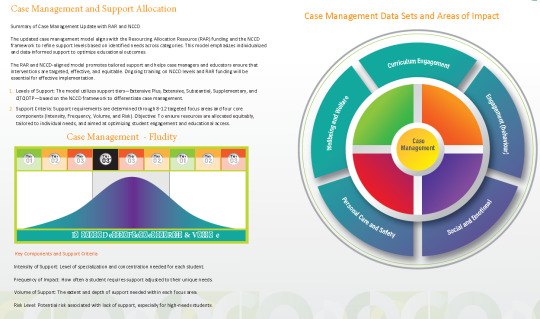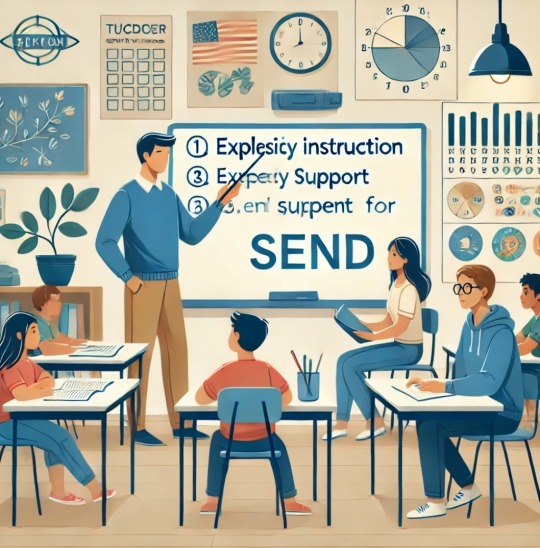Don't wanna be here? Send us removal request.
Text

The Power of Diagnosis Disclosure in Reducing #Stigma for Autistic Students
Having never dove a little further, I was keen to discover some of the critical elements, positive and negative, of students with access needs utilizing distance education practices and learning from their environments. The best method is to break these down into positive and negative elements. We can look at the research, but it comes down to a personalized approach.
One unexpected benefit of #VirtualLearning is the opportunity for diagnosis disclosure to reduce #Stigma. In virtual classrooms, where interactions can be more structured and controlled, disclosing an #AutismDiagnosis has been shown to foster understanding and empathy among peers and educators. When classmates and teachers know a student's autism, they're more likely to approach interactions with patience and respect, creating a more inclusive and supportive learning environment.
This shift in perception helps break down stereotypes, building an atmosphere where #AutisticStudents feel comfortable participating and engaging without fear of judgment. Schools that encourage openness about autism and train teachers in #AutismAwareness play a critical role in reducing the social distance often felt by autistic students.
Inclusion isn't just about giving autistic students a seat at the table; it's about fostering an environment where they're fully understood, accepted, and valued. Virtual learning platforms can help create that environment by promoting transparency and empathy. #Inclusion #EducationForAll #SocialInclusion #Neurodiversity #TechnologicalTools Enhancing Engagement for #Autistic Students
0 notes
Text
Building a Culture of Inclusion with Data-Driven Adjustments in Special Education

Quantitative data is a powerful tool for supporting inclusion in special education by helping educators and policymakers make data-driven adjustments. With measurable data on student performance and outcomes, schools can identify gaps, address disparities, and allocate resources to meet the specific needs of students with disabilities.
For example, if quantitative data highlights an achievement gap between students with and without disabilities, this signals a need for targeted interventions.
These might include specialized tutoring, access to assistive technology, or curriculum modifications that make learning more accessible (International Journal of Social Learning, 2021). Quantitative insights allow leaders to address inequities and work towards an educational environment where all students can succeed.
By fostering a culture of data-driven improvement, educators and administrators can make adjustments that benefit students, promote inclusion, and ensure that reasonable adjustments are meaningful and impactful.
References:
International Journal of Social Learning. (2021). Data-Driven Decision Making in Inclusive Education. Retrieved from https://doi.org/10.1016/j.ijsl.2021.03.021
Wolford, B. (2017). Improving Special Education Outcomes through Policy, Teacher Practice, and Student Support: A Qualitative Study. ProQuest LLC.
#InclusiveEducation #QuantitativeData #SpecialEducation #EducationEquity #DataDrivenDecisions #ReasonableAdjustments #StudentSupport #AssistiveTechnology #AchievementGap #EducationalInclusion #EvidenceBased #EducationInnovation
0 notes
Text
Harnessing the Power of Quantitative Data in Special Education

Sometimes, we need help to see the value of quantitative data in education support. We need to embrace its qualities.
Quantitative data is a cornerstone of evidence-based decision-making in Special Education. By providing measurable, objective insights into student performance, program effectiveness, and overall trends, quantitative data empowers educators and policymakers to craft impactful and accountable strategies.
Assessing Program Effectiveness Quantitative data, like test scores, attendance rates, and graduation rates, allows schools to evaluate the effectiveness of specific programs. For instance, if a school implements a new reading intervention, tracking improvements in literacy scores over time can objectively demonstrate the program’s success—or reveal areas for improvement.
Tracking Student Progress and Outcomes Data-driven insights help teachers understand how well students progress towards their Individualized Education Program (IEP) goals. Regular assessments of reading levels, math proficiency, and behaviour metrics provide concrete evidence of where a student is thriving and where additional support is needed. This enables educators to make timely adjustments, ensuring each student has the best possible chance of success.
Informing Policy and Resource Allocation Policymakers rely on quantitative data to understand the broader needs of special education programs. Data like funding impacts, staff-student ratios, and technology use help leaders allocate resources where needed, ensuring that schools have the support they need to serve students effectively. For instance, analyzing student-teacher ratios in special education classrooms can help allocate resources to optimize support.
Identifying Trends and Predicting Needs Longitudinal data—tracking trends over time—helps predict future needs. By examining patterns such as growth in the number of students requiring special education services or increasing rates of diagnoses, school districts can better prepare for changing demands. This forward-thinking approach is crucial for making informed decisions about staffing, curriculum, and facilities to meet the evolving needs of Special Education.
Supporting Inclusion and Equity Quantitative data highlights disparities in Special Education, revealing where improvements are needed to support inclusion and equity. For instance, if data shows a significant achievement gap between students with and without disabilities, it signals an area that needs targeted intervention. This awareness fosters accountability and prompts educators and policymakers to address disparities, promoting a more inclusive learning environment.
Quantitative data provides the hard evidence to support, improve, and advocate for Special Education. By systematically tracking progress, evaluating programs, and identifying gaps, educators and leaders are better equipped to drive meaningful change and ensure that all students have the opportunity to thrive.
References: ERIC. (2018). Quantitative Analysis in Educational Policy. Accessed from ERIC database. Alnaim, M. (2018). Quantitative Data in Special Education: Evaluating Interventions. Education Quarterly Reviews. International Journal of Social Learning. (2021). Data-Driven Decision Making in Inclusive Education.
0 notes
Text
Using Research to Shape Inclusive Policies in Special Education

In special education, effective policies must go beyond numbers to capture the voices of those directly involved. Qualitative research methods, like interviews and focus groups, allow policymakers to understand how policies impact students, teachers, and families daily.
For example, teachers’ feedback might highlight practical challenges in implementing certain inclusive practices, leading to adjustments that improve training and support.
Observational studies and real-time feedback provide insights for policymakers to make informed, responsive changes that benefit all stakeholders. Grounding policies in both quantitative data and qualitative experiences can help build a more inclusive, effective education system.
References:
International Journal of Social Learning. (2021). Exploring Special Education Policy through Qualitative Analysis.
Wolford, B. (2017). Improving Special Education Outcomes through Policy, Teacher Practice, and Student Support.
#EducationalPolicy #QualitativeResearch #SpecialEducation #InclusiveEducation #TeacherVoice #PolicyDevelopment #EducationImprovement #DataDrivenEducation #AdaptiveStrategies #EducationLeadership
0 notes
Text
The Need for Equitable Access to #VirtualLearning for Autistic Students
Tools like #Teletherapy, video-based learning, and interactive virtual platforms aren't just convenient—they're essential for creating an engaging and supportive learning environment tailored to the unique needs of students with #ASD. For instance, teletherapy allows speech and occupational therapists to work with students remotely, helping them practice crucial skills in a familiar, comfortable setting. This approach not only makes therapy more accessible but also often reduces the anxiety that some autistic students feel in traditional therapy settings.
Other technological tools, like visual schedules and interactive lesson platforms, offer structured and predictable routines that many autistic students thrive on. Visuals, hands-on activities, and structured navigation help students stay engaged and focused, which can lead to better learning outcomes. These tools make a real difference in how autistic students interact with and retain educational content. As we continue to embrace #EdTech, let's prioritize developing and implementing tools that empower autistic students to succeed. A tech-driven approach to #InclusiveEducation doesn't just support individual needs; it paves the way for a more equitable and accessible educational experience.#SpecialNeedsEducation #Telepractice #EdTechForGood #DigitalLearning




AutismSupport
DistanceLearningChallenges
OnlineEducationForAutism
VirtualLearningAutism
InclusiveEducation
AutismAwareness
AccessibilityInEducation
EquityInLearning
SpecialNeedsEducation
AutismAndEducation
ParentingAutism
SupportForAutisticStudents
AdaptiveLearning
TeletherapyForAutism
0 notes
Text
Addressing the Challenges of #DistanceLearning for Autistic Students

Having never dove a little further, I was keen to discover some of the critical elements, positive and negative, of students with access needs utilizing distance education practices and learning from their environments. The best method is to break these down into positive and negative elements. We can look at the research, but it comes down to a personalized approach.
While #DistanceLearning offers unique benefits, it presents significant challenges—particularly for #AutisticStudents. Virtual classrooms lack the face-to-face support many autistic students rely on to navigate their daily learning routines. The online model can fall short for students who need hands-on guidance, personalized instruction, and structured social interaction.
Parents and caregivers are often thrust into the role of educators, especially for students with more complex needs. This shift places a heavy burden on families as they try to adapt lessons and provide individualized support without the expertise of trained educators. Additionally, virtual learning can lead to social isolation for autistic students, who miss out on in-person interactions that help them build critical social skills.
To make virtual learning work for every student, we need a more robust #SpecialEducation support system in the digital space. That includes accessible resources, well-trained virtual teachers, and tools promoting structured student interaction. By addressing these gaps, we can create a more inclusive digital learning experience that works for autistic students and their families. #inclusive Education #AutismSupport #VirtualLearningChallenges #EquityInEducation
0 notes
Text
Sculpting Shadows by John Daedalus

Dive into a world where love, loss, and personal transformation intertwine. Sculpting Shadows by John Daedalus offers a deeply emotional and raw exploration of relationships set against art, trauma, and resilience. Follow Elizabeth Lindfield, a woman torn between the demands of her crumbling marriage and the haunting shadow of an accident that leaves her husband, Robert, paralysed. As they navigate the complexities of love and loss, their once-passionate relationship falters under the weight of guilt, desire, and emotional distance. Their struggles mirror our own, making their journey all the more compelling.
Elizabeth's journey is heartache, self-discovery, and an unyielding search for a new normal. Despite Robert's bitterness and estrangement, her struggle to maintain her marriage and identity pulls readers into a narrative rich with psychological depth and emotional intensity. With themes of mental health, intimacy, and resilience, Sculpting Shadows is more than a love story; it is a gripping tale of healing and self-realisation.
For fans of romance with a touch of psychological complexity, this book promises a rollercoaster of emotions that will leave you reflecting on the human condition long after the final page. Join Elizabeth in this poignant exploration of love's power to shape and sometimes break us. Be prepared to be deeply moved by the characters' emotional journeys.
0 notes
Text
Building Inclusive Education Policies Through Qualitative Research
Building Inclusive Education Policies Through Qualitative Research
In special education, effective policies must go beyond numbers to capture the voices of those directly involved. Qualitative research methods, like interviews and focus groups, allow policymakers to understand how policies impact students, teachers, and families daily.
For example, teachers’ feedback might highlight practical challenges in implementing certain inclusive practices, leading to adjustments that improve training and support.
Observational studies and real-time feedback provide insights for policymakers to make informed, responsive changes that benefit all stakeholders. Grounding policies in both quantitative data and qualitative experiences can help build a more inclusive, effective education system.
References:
International Journal of Social Learning. (2021). Exploring Special Education Policy through Qualitative Analysis.
Wolford, B. (2017). Improving Special Education Outcomes through Policy, Teacher Practice, and Student Support.
0 notes
Text
Support plans
Support plans for students with disabilities in high school play a crucial role in fostering educational success and ensuring a smooth transition to post-secondary life.

Below are the key areas that recent research highlights as essential for creating effective support plans:
1. Individualized Transition and Support Plans An individualised approach to transitioning from high school to post-secondary education is critical for students with disabilities. Transition plans include tailored strategies to address each student's needs, ensuring they have the necessary tools and support to navigate the challenges beyond high school. These plans help prepare students for both academic and non-academic post-graduation challenges. Reference: Dong, K. (2024).
Perspectives of College Students with Disabilities Regarding Their High School Transition Experiences: Notes for High School Transition Planning. ProQuest. Retrieved from ProQuest Link.
2. Educational and Vocational Support
Mechanisms High school support plans often focus on academic accommodations and vocational training. This dual focus ensures students progress in their educational journey and develop crucial skills for their future careers. Vocational programs are essential to helping students with disabilities transition from school to employment. Reference: O'Dellick, M. (2024). Career and Technical Education Teachers' Perceptions of the Impact of School-Wide Positive Behavior Interventions and Supports on Their Professional Growth and the Preparation of Students with Disabilities for the Workforce. Pennsylvania State University. Retrieved from PSU Link
3. Social and Behavioral Interventions Social and behavioural needs are integral to the success of students with disabilities. Many high schools implement behavioural intervention programs that focus on helping students regulate their emotions and improve social engagement. This support fosters a sense of belonging and promotes positive behaviour within the school environment. Reference: Clay, M.K. (2024). The Impact of Burnout Symptoms on Adapted Physical Education Specialists' Teaching Experiences. Ohio State University. Retrieved from Ohio State

Link 4. - Assistive Technology and Accommodations Technology is a crucial enabler for students with disabilities. Assistive tools such as visual aids, activity schedules, and speech-to-text applications can significantly enhance the learning experience. These accommodations help students perform daily school tasks more efficiently and achieve academic success. Reference: Milam, M.E., & Sutton, K.K. (2024). Using Visual Activity Schedules to Improve Transitioning for Students With Emotional and Behavioral Disorders. Beyond Behavior, SAGE Publications. Retrieved from SAGE Link By focusing on transition planning, educational and vocational support, social and behavioural interventions, and assistive technology, schools can ensure that students with disabilities are fully supported in their academic journey and prepared for life beyond high school.
0 notes
Text
Moving Towards Inclusion: Challenges and Opportunities for Specialist Teachers
In term 4, I typically look at reviewing, auditing, and just taking stock of process policy procedures that may need refining or have failed or anything worth investigating. One thing I noticed this term, especially as my focus has been coaching and developing support educators, is a substantial lack of deep knowledge of understanding impact and frequency and the language and processes around identifying these for students with access needs. There is no blame directed at anyone. During the last two terms, I spent almost 15 to 20 hours a week supporting specialist staff, head of support services and 20 case managers. I am lucky to have a head of support services with extensive experience and knowledge of the old verification process. I decided to dive deep into the data and research to see if this process is formal. I did this because the focus is significant that All education staff, particularly those working with access needs, understand the complexity, frequency and intensity of these impacts and how evidence and data establish support mechanisms to make these components of those impacts.Moving Towards Inclusion: Challenges and Opportunities for Specialist Teachers and Access NeedsThe Evolving Role of Specialist Teachers in Inclusive Education
Introduction:
As education progresses toward a more inclusive model, the role of specialist teachers in the realm of access needs has evolved. This shift raises the question of whether this movement has affected the development of specialist teachers who play a critical role in coaching curriculum teachers in core skills such as differentiation and modification, particularly within the frameworks of Individual Curriculum Plans (ICP) and Queensland Certificate of Individual Achievement (QCIA) (Schwab et al., 2024).#Inclusion #SpecialEducation #AccessNeeds
Key Point 1: Impact on Specialist Teachers' RolesThe move towards inclusion often places specialist teachers in dual roles as classroom educators and experts who guide their peers. This dual responsibility can significantly impact their ability to focus solely on coaching and mentoring. While their involvement in the classroom enhances credibility and the delivery of support, it also underscores the need for teachers to deeply understand personalized access needs, trauma, and how to manage these complexities within an inclusive classroom setting (Hasson et al., 2024).#SpecialistTeachers #DualRoles #InclusiveClassroom
Key Point 2: The Necessity of Comprehensive TrainingAs outlined by Schwab et al. (2024), positive teacher attitudes and training are crucial for fostering effective inclusive practices. However, the current climate in Australia, characterized by a crisis in teaching, indicates that many professionals entering the specialization area of access needs may not possess the same depth of knowledge regarding personalization and the specific skill sets required to manage curriculum, social-emotional learning, and personal care.#TeacherTraining #ProfessionalDevelopment #InclusiveEducation

Conclusion:
Gone are the days when support staff and heads of inclusion primarily focused on the language of impact frequency and support types. Educators need to understand the broader picture—documenting and communicating the Nationally Consistent Collection of Data (NCCD) levels of access needs while aligning this evidence with personalized learning plans. In this evolving landscape, developing these skill sets remains
highly valued for understanding classroom practices (Mendoza & Heymann, 2024).#NCCD #PersonalizedLearning
0 notes
Text
Implementing Effective Behavior Support Plans for Student Success
Implementing Effective Behavior Support Plans for Student SuccessSupporting students with challenging behaviors is key to creating productive classrooms. Individual Behavior Support Plans (IBSPs) are valuable tools for helping students manage their emotions and behaviors.
This post provides a brief overview of creating an IBSP based on academic research and practical insights.
Step 1: Identifying Behaviors and Triggers
The first step in developing an IBSP is identifying problematic behaviors and their triggers. Students may exhibit avoidant behaviors when they feel misunderstood or overwhelmed. Visual models, such as the "Red Zone" and "Green Zone," can help teachers and students recognize early emotional states and prevent escalation.
Step 2: Recognizing Escalation Patterns
Monitoring behavioral escalation is essential to effective intervention. The Functional Behavior Escalation Guide shows the progression from calm states to crisis situations. Early identification of these stages allows teachers to intervene before behaviors worsen, using proven strategies for de-escalation (Simonsen et al., 2008).
Step 3: Positive Behavioral Supports
After identifying triggers, positive behavior supports (PBS) should be applied. This includes individualized behavior intervention plans (BIPs) that reinforce adaptive behaviors. Research by Alwahbi (2024) demonstrated the effectiveness of virtual PBS programs in improving behavior among students with autism, while Martins et al. (2024) emphasized mentoring programs' role in boosting self-regulation and engagement.
Step 4: Monitoring and Adjusting the Plan
An IBSP must be monitored and adjusted as needed. Ongoing assessments improve success rates (McGuire et al., 2024). Regular feedback from students, teachers, and parents ensures the plan remains relevant and effective.
Conclusion
An IBSP is a dynamic tool that supports students in managing behaviors through early intervention, positive supports, and ongoing evaluation. With evidence-based practices, teachers can help students thrive in academic and social settings.
References
Alwahbi, A. A. (2024). The efficacy of virtual positive behavior support in a special school for students with ASD. Journal of Behavioral Education.
Martins, J., Rosário, P., Cunha, J., Núñez, J. C., & others. (2024). How to help students in their transition to middle school? Contemporary Educational Psychology.
McGuire, S. N., Meadan, H., & Folkerts, R. (2024). Classroom and behavior management training needs and perceptions: A systematic review of the literature. Child & Youth Care Forum.
Simonsen, B., Fairbanks, S., Briesch, A., Myers, D., & Sugai, G. (2008). Evidence-based practices in classroom management: Considerations for research to practice. Education and Treatment of Children, 31(3), 351-380.
#BehaviorSupport #ClassroomManagement #IBSP #PositiveBehaviorIntervention #SpecialEducation #StudentSuccess #TeacherResources #MentalHealthInSchools #InclusiveEducation #AcademicResearch #AutismSupport #TeacherTraining #EducationalPsychology---This version includes relevant hashtags to enhance visibility and engagement for educators and professionals in behavior management fields.

0 notes
Text
Data-Driven Decision-Making in Education: Key to Success with Process-Oriented Leadership

Data is central to education, particularly in process-oriented leadership. It enables leaders to make informed decisions, improve strategies, and enhance student outcomes, ensuring efficient resource use and timely interventions.
The Role of Data in Process-Oriented Leadership
Data offers critical insights into areas requiring improvement. School leaders can use student performance data to highlight strengths and weaknesses, teacher performance data to improve instructional practices, and school-wide data on attendance and behavior to provide a broader view. This information guides decisions on resource allocation and intervention timing.
Benefits of Data-Driven Decision-Making
Targeted Interventions: Data helps identify students needing support, allowing schools to implement effective strategies like the RTI model.
Informed Instruction: Teachers adjust lessons based on data to better meet student needs.
Enhanced Accountability: Data sets clear goals, fostering accountability at all levels.
Building a Culture of Data-Driven Leadership
For effective data-driven decision-making, schools must foster a culture where data is valued and understood. This includes professional development to empower teachers and leaders in data analysis, collaborative decision-making where staff collectively review data to shape strategies, and ongoing monitoring to support dynamic decision-making and improvement.
Challenges and Solutions
Challenges like data overload and misuse can arise but can be addressed by focusing on key data points to avoid overwhelming staff, offering ongoing support to improve data interpretation skills, and establishing ethical guidelines to ensure data is used properly.
Conclusion
Data-driven decision-making is a critical part of process-oriented leadership. Schools that prioritize data usage can expect improved interventions, accountability, and overall student success.
0 notes
Text
Mind Maps and Cognitive Decline

The Concept Behind Mind Maps Mind maps, a concept developed by Tony Buzan in the 1970s, are visual tools used to organize information in a hierarchical manner, showcasing the relationships between various ideas or pieces of information. The core idea is positioned centrally, with branches extending outwards to represent critical concepts, which can be further subdivided into smaller sub-concepts. This non-linear structure promotes a more flexible and creative approach to organizing and retrieving information.
Cognitive Science Behind Mind Maps Mind maps leverage several principles of cognitive psychology, including dual coding theory, network models of memory, and spatial memory utilization. Dual coding theory, introduced by Allan Paivio in 1971, posits that information is stored in memory in both verbal and visual forms.
Mind maps take advantage of this by combining text with images and spatial arrangements, thereby enhancing recall and comprehension (Paivio, 1971). The hierarchical nature of mind maps also mirrors the network models of memory, where knowledge is stored in interconnected nodes. Gordon Bower (1970) suggests that the more connections a piece of information has, the easier it becomes to retrieve. Mind maps facilitate the creation of these connections by visually depicting relationships between concepts (Bower, 1970).

Mind Maps and Cognitive Decline Research indicates that engaging in cognitively stimulating activities, such as creating mind maps, can slow cognitive decline, particularly among older adults. These activities promote neural plasticity and cognitive reserve, which are essential in maintaining cognitive function as one ages. Key References - Bower, G. H. (1970). Imagery as a relational organizer in associative learning. Journal of Verbal Learning and Verbal Behavior, 9(5), 529-533. - Paivio, A. (1971). Imagery and verbal processes. Holt, Rinehart, and Winston. Summary Hashtags #MindMaps #CognitiveScience #DualCodingTheory #MemoryNetwork #CognitiveDecline #TonyBuzan #NeuralPlasticity #CognitiveReserve
0 notes
Text
Supporting High-Quality Teaching: The Five-a-day Principle in Practice
Supporting High-Quality Teaching: The Five-a-day Principle in PracticeThis week, we embarked on developing the Five-a-day principle to support teachers and their work in the classroom. The Five-a-day principle emphasizes strategies that improve outcomes for students with Special Educational Needs and Disabilities (SEND). By focusing on areas like explicit instruction and cognitive strategies, this principle helps teachers deliver high-quality education. According to the Education Endowment Foundation, these strategies are crucial in enhancing student performance and engagement.Explicit instruction involves clear explanations, modeling, and guided practice, ensuring students understand the material. This approach is particularly effective for students with SEND, as it breaks down complex tasks into manageable steps. Teacher aides play a vital role in this process, providing support and reinforcement as needed.Teacher aides are instrumental in implementing the Five-a-day principle, particularly in providing scaffolding and personalized support. Their collaboration with teachers ensures that students receive the help they need to succeed. #InclusiveEducation #ExplicitInstruction #TeacherAides #ScaffoldingReferences:Davies, K., & Henderson, P. (2020). Special Educational Needs in Mainstream Schools: Guidance Report. Education Endowment Foundation. https://eric.ed.gov/?id=ED609803Sharples, J., Blatchford, P., & Webster, R. (2016). Making best use of teaching assistants. Education Endowment Foundation. https://discovery.ucl.

#books#books and art#books & libraries#books and literature#books and coffee#education and learning#education consultant
1 note
·
View note
